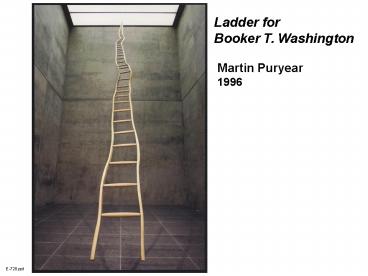E728'ppt - PowerPoint PPT Presentation
1 / 25
Title: E728'ppt
1
Ladder for Booker T. Washington
Martin Puryear 1996
E-728.ppt
2
Scissors Diagram Showing the Gender Distribution
within Career Stages in Biological Sciences at
German Universities (2003)
K. M. Neugebauer, Keeping Tabs on the Women
Life Scientists in Europe (2006) PLoS Biology,
40494
3
Rules for Choosing a Postdoc Lab
- Visit the lab, if possible.
- Ask/find out about
- What do postdocs do when they leave the lab?
- Do most/many postdocs have their own fellowships?
- Does the lab interact with other labs in the
vicinity? - Do lab members attend external meetings?
- Are projects usually/seldom collaborative?
- How did the mentor react to your suggestions for
a project? - Are people in the lab having FUN doing science?
- Choose a lab where you can learn something new.
4
Information on Postdoctoral Funding for US Labs
- Many universities have websites available that
list information on postdoctoral fellowships.
These include deadlines for submission, synopses
of the programs, and links to the agency
websites. - Usually the information also states whether
foreign nationals can be supported. A good
example is the website called Postdoctoral
Fellowships in the Biological Sciences from the
University of California at Berkeley - http//www.spo.berkeley.edu/Fund/bi
opostdoc.html - It lists 61 fellowship opportunities in various
biological subfields. Of these, over half are
available to non-US citizens or permanent
residents.
5
Rules for Successfully Applying fora
Postdoctoral Fellowship
- Develop your own project (at least the details).
- With every specific aim, include potential
pitfalls and ways of overcoming them. - Emphasize new technologies/skills you will
acquire. - Do not continue an existing collaboration.
- If you are remaining in the same university,
institute or city, be up front about why. - List titles and authors of in preparation
manuscripts, but be sure to check with your
advisor first. - Choose your non-advisor referees carefully.
6
(No Transcript)
7
(No Transcript)
8
The flat NIH budget of the past four years has
resulted in the lowest level ever compared with
the historical growth rate
28.93B (2007)
2003
1999
The doubling of the NIH budget (1999-2003) was
simply a restoration to the level of the
historical growth rate
(log scale)
1.51B (1972)
9
(No Transcript)
10
(No Transcript)
11
In addition to these federal agencies, there are
also many foundations that provide awards for
early-career investigators.
12
Rules for Starting Your Own Lab
- Remember, you are the best person in your lab.
Work yourself on the most important projects. - Dont give your critical projects to
inexperienced students. If they do something that
works, great. If not, you wont be held back. - It is worse to accept an inadequate postdoc/grad
student than none at all. - Early on, avoid committee work. Do a good job at
a few things. - Do not sit on gt3x the number of research
committees relative to the students you have
your faculty colleagues will not be upset.
13
The basics of mentoring Of undergraduates Of
graduate students Of postdocs Of junior faculty
14
- More details on how to mentor
- Choosing suitable projects.
- Setting goals and expectations.
- Identifying and resolving challenges.
- What we have learned from successful mentors.
15
- What a new investigator needs to know about
- Choosing lab members.
- Dealing with a group.
- Organizing a lab.
- Getting funding.
16
- How-to guide for starting an independent
position - How to negotiate.
- Leading a lab.
- Time, project and data management.
- Getting published and funded.
- Teaching and course design.
17
Running a meeting or a training event? Heres how.
18
(No Transcript)
19
Succeeding in Science Some Rules of
Thumb James D. Watson Science (1993) 261, 1812.
- To succeed in science, you have to avoid dumb
people.
?To make a huge success, a scientist has to be
prepared to get into deep trouble.
- Be sure you always have someone up your sleeve
who will save you when you find yourself in deep
s___.
- Never do anything that bores you.
- If you cant stand to be with your real peers,
get out of science.
20
Yale University Press, New Haven, London 2006
21
(No Transcript)
22
Some conclusions from the report Beyond Bias and
Barriers Fulfilling the Potential of Women in
Academic Science and Engineering, National
Academy of Sciences (Donna Shalala, Chair)
- Gender biasoften unexamined, and even held and
acted upon by individuals of both sexes who
believe themselves unbiasedhas affected many
women scientists chances of career progress. - Incidences of bias against individuals not in
the majority group tend to accumulate. Over
time, an accumulation of small preferences adds
up to large differences between the prestige,
power and position of those subject to bias and
of those unaffected by it. For example, as
postdocs, women write more grants and men more
papers. - In academic science and engineering, the
advantages have accrued over time to white male
scientists and have translated into greater
salaries, promotions, publications, honors and
resources compared to those of women.
23
The committee is deeply concerned that the
scientific and technical building blocks of our
economic leadership are eroding . We fear the
abruptness with which a lead in science and
technology can be lost and the difficulty of
recovering a lead once lost -- if it can be
regained at all.
24
Increase the federal investment in long-term
basic research 10 annually over the next 7
years.
25
JSC Member Societies The Joint Steering
Committee for Public Policy (JSC) is a coalition
of five biomedical societies representing more
than 60,000 researchers in the fields of cell
biology, genetics and neuroscience. The JSC was
formed in 1990 to bring scientists together to
advocate for federal funding for basic biomedical
research. American Society for Cell Biology
(ASCB). American Society for Clinical
Investigation (ASCI) Genetics Society of America
(GSA). Science Service Society for Neuroscience
(SFN).






























